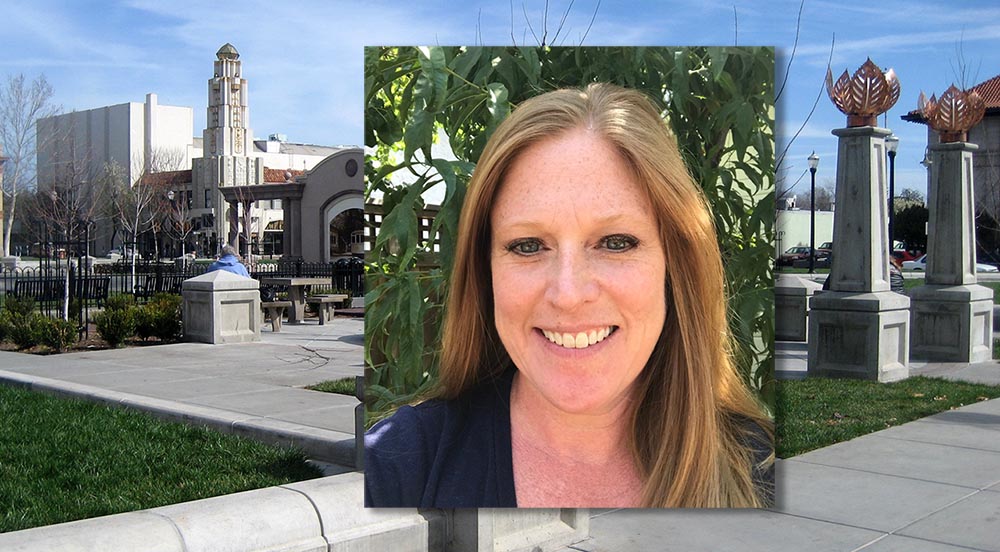
(Photo courtesy of Courtney Farrell; Photo of downtown Chico: Suzi Rosenberg/Flickr)
California Forward is committed to advancing policy intersections that create a more inclusive and sustainable California where all people can prosper. The Voices of Shared Prosperity series amplifies the stories of Californians who are committing their time and talent to solutions that embrace equity, environmental sustainability, and economic opportunity.
When Courtney Farrell became an intern at the Center for Economic Development (CED) as a college student, she realized she found her life’s work.
“As I learned about what the work that the CED did and how is benefitted the North State and what the need was,” Farrell said, “I just fell in love with it and it became my passion.”
Today, Farrell is a project manager for the CED, a division of the North State Planning and Development Collective (The Collective) at California State University at Chico. In partnership with the Collective’s executive director, Jason Schwenkler, she works to encourage economic development in the 12 North State counties through business assistance, regional convenings, partnerships, transformational initiatives and training the next generation of economic development professionals through a paid internship program.
“We try to support projects or communities or initiatives throughout the region with our data expertise,” said Farrell, noting that some of the studies and research are financially out of reach for many of the businesses they serve.
Through its Business Assistance Program, CED helps businesses use research and technology, such as website development and optimization, customer demographic and spending reports, funding and market research and the utilization of social media.
During the pandemic, CED found 60% of the businesses they worked with did not have a web presence, making the transition to e-commerce impossible. “We developed a grant-funded TA program where we were creating websites for our businesses for free,” said Farrell.
| With more activities moving online, the percentage of the population with access to broadband internet is key to a thriving economy. In the Shasta/Cascades region, broadband access increased from 61% in 2010 to 84% in 2020. Learn more about broadband access in your region with our California Dream Index, which tracks 10 indicators of economic mobility. |
|---|
Bringing resources to the North State also plays an important role in Farrell’s work. The Collective/CED was among an eight-partner collaborative, led by the Foundation of California Community Colleges, to receive a $21.5 million grant through the Good Jobs Challenge funded by the American Rescue Plan. “It’s this recent shift in the North State that is starting to resonate – if we work together, we can actually get a lot done,” said Farrell.
Earlier this year, CED was awarded the designation as an Economic Development Administration (EDA) University Center along with California State University at Fresno and California Polytechnic State University, San Luis Obispo to build regional economic ecosystems. Added Farrell, “It serves as the seed for our ability to leverage the funding to do these grander projects and to really tackle projects regionally.”
The internship that started Farrell’s career is another important aspect of CED. “We really try to give our students that real world experience on projects, so that when they graduate, they can go on to have better jobs.” CED interns gain valuable experience working on local and regional economic development projects while also learning communication skills and how to research, understand and implement data. “It’s a mix between the tangible skills and the soft skill development,” said Farrell who worked in other economic development organizations after her internship before returning to CED.
Farrell is also leading Community Economic Resilience Fund (CERF) convenings for the North State region, a process she enjoys because it involves the many sectors of the local community. “We’ve been here for so long,” she said. “We do have to take care of each other, and now is the time more than ever. The key thing is for us to be organized together.”
Farrell’s plan for the future with the Collective/CED includes more collaboration and economic development. “This next year or so, we’re really pushing hard to get out to our really far communities – Modoc, Lassen, and Plumas Counties.” She explained these regions are among the most resource challenged for a variety of factors. Her team makes sure they attend local meetings, connect with partners and offer business, technical and grant writing assistance.
“We’re here to be a resource for our region. We’re here to be a strong partner. We’re also here to take a leadership position to ensure that the North State is at the table.”

